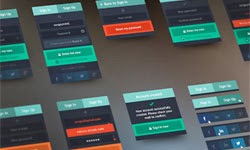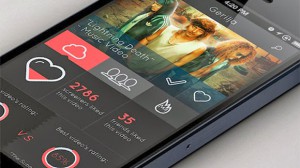 Today, web design has become a very lucrative and popular professional career. With so many web technologies available today, we often find beautiful sites designed to look professional, yet stylish and flashy. One stream of web designers, however, decided to show the world how simplistic styles can be made to look beautiful as well. This is the start of a Flat UI or Flat Web Design revolution.
Today, web design has become a very lucrative and popular professional career. With so many web technologies available today, we often find beautiful sites designed to look professional, yet stylish and flashy. One stream of web designers, however, decided to show the world how simplistic styles can be made to look beautiful as well. This is the start of a Flat UI or Flat Web Design revolution.Flat Web Design
Flat UI or a flat web design involves designing web elements with a flat, simplistic user interface and experience, which maintains simplicity and also manages to look professional, beautiful and unique. With a flat UI, almost all of the extra visual elements that accompany a graphic object on a website are removed. With all the extra styles, bevels, textures, gradients and other such things stripped off, the graphic elements retain only the design and the colors used to form the design, which reminds the viewer of a two-dimensional imagery of sorts.

One could ask exactly why flat website design is gaining momentum. The reason being flat design allows for provision of a finished, austere design that can form a canvas of sorts, upon which more complex and advanced interfaces can then be built and implemented. One must understand that while the flat element is stripped of its gradients and effects, it still maintains its primitive design structure and style forms. Extra emphasis is now put on the accessibility and legibility of content and user experience by removing unnecessary elements and styles of design that impact on page load and site performance, along with ease of access and navigation.
A Little History
As often is the case with most technologies, the web domain has also been prone to major shifts in trends, in terms of technologies being used and the design styles being employed. Flat design, in the beginning, was hailed as the simplistic design that is elegant and is not flashy in nature. Today, minimalistic interfaces are the rage, and flat UI has picked up its own fan following. One simple, yet powerful example of flat UI design implementation would be Apple’s iOS 7. With flat icons and simple looks, iOS7 manages to give out a professional, clean and simple look whilst removing cluttered and data interface styles and visual elements. Another example of flat design would be Microsoft’s attempt at a flat user interface that started with the Zune Player. Today, Windows 8’s metro UI also draws heavily from flat file design concepts and was one of the initially sparks for this trend.
Tips on Implementing
Do not Add Effects: The more effects that are added to a design element of a website, the more the complexity becomes. Keeping everything simple is the most important aspect of a flat design.
Use Simple Elements: Simple element designs work wonders when used in the right way. Sticking to a simplistic, yet effective design is one of the fundamental ideologies behind a flat design.
Typography: Since the designs of flat UI elements happen to be simplistic and almost austere, it is very important to give special importance to typography. After all, text is often the most important thing within a site. Choosing a simple, yet elegant set of fonts that match your brand’s guidelines is critical when going for a flat user interface approach.
Color: Ensure that the colors used on a flat website complement each other well. Since there are no other details that will beautify the site, it is highly important to use the right combination of colors to give the site the beauty it deserves.
About the Author
 Mathew Porter is a Web Designer and Developer with over 8 years industry experience and has seen a variety of trends and changes take shape online.
Mathew Porter is a Web Designer and Developer with over 8 years industry experience and has seen a variety of trends and changes take shape online.
